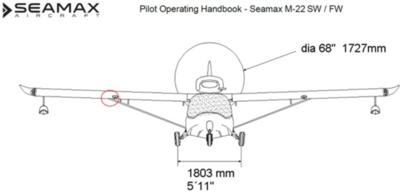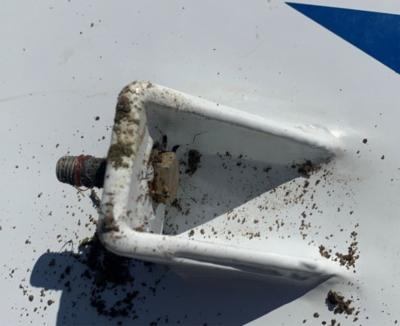The Entire Right Wing Was Separated From The Main Wreckage And Located In A Tree
Location: East Hampton, NY Accident Number: ERA23FA007
Date & Time: October 6, 2022, 12:29 Local Registration: N46PD
Aircraft: Seamax Aircraft M-22 Injuries: 1 Fatal
Flight Conducted Under: Part 91: General aviation - Personal

On October 6, 2022, at 1229 eastern daylight time, a Seamax Aircraft M-22 airplane, N46PD, was destroyed when it was involved in an accident near East Hampton, New York. The private pilot was fatally injured. The airplane was operated as a Title 14 Code of Federal Regulations Part 91 personal flight.
According to surveillance video, the pilot arrived at the airplane hangar at East Hampton Town Airport (JPX), East Hampton, New York, at 1159. At 1206, he pulled the airplane out of the hangar. Between 1206 and 1208 the pilot performed a preflight inspection, entered the airplane, shut the canopy, and started the engine at 1209. At 1214, the airplane began to taxi for departure.
Preliminary Automatic Dependent System – Broadcast (ADS-B) data indicated that the airplane departed runway 28, at 1219. Then, the airplane flew south over the water, east, and made a turn north. As the airplane was over Three Mile Harbor, ADS-B contact was lost. The airplane’s most recent flight before the accident flight occurred on September 30, 2022. A witness reported that he heard the engine of an airplane flying over, which drew his attention. Then, he heard a loud “crack,” saw a wing separate from the airplane, and the airplane spiral down into the water.

The airplane came to rest in about 3-4 ft of water in the Three Mile Harbor. The right wing came to rest in a tree that was about 770 ft from the main wreckage. Examination of the engine revealed that the engine was impact separated from the fuselage but remained attached to the engine mounts. There were no holes in the crankcase. All 4 cylinders remained attached to the engine. The carburetors were impact separated from the engine but remained attached through fuel lines. Both carburetor butterfly valves could be operated by hand. The spark plugs were removed and examined. All were light grey in color and exhibited minimal wear. The rocker box covers were removed and there were no anomalies noted with the rocker arms or valve springs.
Examination of the propeller revealed it remained attached to the engine. One propeller blade remained attached to the propeller hub. It exhibited chordwise scratching and leading-edge gouging. Another blade was separated from the propeller hub, was located in the vicinity of the main wreckage, and exhibited chordwise scratching. The third propeller blade was not recovered.

Examination of the airframe revealed that the fuselage was fragmented. Flight control continuity was confirmed from the flight control surfaces to the cabin through multiple breaks and overload failures. The right stabilator remained attached to the empennage and exhibited leading edge damage. The inboard section of the left stabilator remained attached to the empennage. The outboard section was impact separated and located in the vicinity of the main wreckage. The rudder remained attached to the vertical stabilizer and exhibited impact damage. The left wing was fragmented, but the left aileron, left flap, and left wing tip were located. The left wing strut was impact separated from the wing and the strut attach point bolt remained secure with the nut.
The entire right wing was separated from the main wreckage and located in a tree. The right aileron remained attached to the right wing. The right flap was separated from the right wing and located in the vicinity of the right wing. The right wing strut was separated from the right wing. The bolt attaching the right strut to the right wing remained attached to the right wing and was not fractured; however, the nut was not present. In addition, the bolt threads did not exhibit significant damage. The right and left wing strut assemblies were retained and sent to the NTSB Materials Laboratory for further examination.
 ANN's Daily Aero-Term (05.17.24): Very High Frequency
ANN's Daily Aero-Term (05.17.24): Very High Frequency ANN's Daily Aero-Linx (05.17.24)
ANN's Daily Aero-Linx (05.17.24) ANN FAQ: Submit a News Story!
ANN FAQ: Submit a News Story! Classic Aero-TV: ANN Visits Wings Over The Rockies Exploration Of Flight
Classic Aero-TV: ANN Visits Wings Over The Rockies Exploration Of Flight Airborne Affordable Flyers 05.16.24: PRA Runway, Wag-Aero Sold, Young Eagles
Airborne Affordable Flyers 05.16.24: PRA Runway, Wag-Aero Sold, Young Eagles





